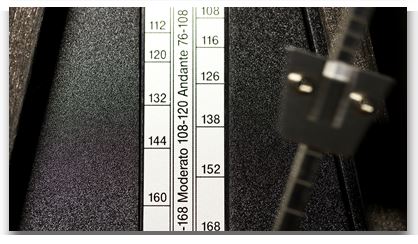 Have you ever had trouble mastering the timing of a lick or riff that you’ve been practicing? If you have, then you’ll know that it can be a very frustrating experience—especially if you’ve put in hours of diligent work and still can’t get the timing perfected!
Have you ever had trouble mastering the timing of a lick or riff that you’ve been practicing? If you have, then you’ll know that it can be a very frustrating experience—especially if you’ve put in hours of diligent work and still can’t get the timing perfected!
To make matters worse, it can also be very hard to determine exactly why the timing doesn’t sound like the guitarist that you’re trying to emulate. This means that you won’t know what you need to change in order to perfect the timing of what you’re learning.
Because of this, I thought it would be helpful to give you some tips on pinpointing the causes of any timing problems that you might be experiencing. While knowing the causes won’t automatically solve the problems, it’s a critical first step.
Three Common Causes Of Timing Problems
I’ve taught hundreds of guitarists over the years, and have found that most problems with timing can be put into three broad categories…
- Physical: This is when the physical movements of playing are causing the timing to go out of whack.
- Perceptual: This is when the you can’t clearly hear in your head the timing of what you’re trying to learn.
- Internalisation: This is when the material simply hasn’t been learnt well enough.
Let’s take a look at each of them in more detail…
Identifying Guitar Timing Problems Caused By Physical Issues
A huge number of timing problems are caused by awkward fretting-hand or picking-hand movements that are difficult to play. In other words, if you’re struggling to actually play the notes fluently, then playing with awesome timing is pretty much going to be impossible!
Because of this, it’s a great idea to slowly play through what you’re learning and look for…
- Fretting-hand movements that are particularly awkward. For Example: If a guitar lick you’re learning has a really big stretch in it, then that’s definitely a potential cause of timing problems.
- Picking-hand movements that are very challenging. For Example: If you’re learning a lick that uses string-skipping, then those movements could potentially cause the timing to go out of whack.
- They don’t know exactly what finger is meant to be playing each note.
- They don’t know what pick-stroke should be playing each of the picked notes. (i.e. they don’t know what note should be played with a downstroke, and what note should be played with an upstroke).
If this is the case with you, then there’s a good chance that some of your troubles with timing stem from not practicing what you’re learning in a strategic way.
If you’ve just gone through the analysis that I’ve recommended, and honestly don’t feel that any of the movements are awkward, then you can move onto the next step…
Identifying Guitar Timing Problems Caused By Perceptual Issues
If you can’t clearly hear the timing of what you’re learning in your head, then it will be virtually impossible to play it accurately. So it’s really important to test yourself by doing the following two things at a comfortable speed…
- Clapping: Clap the timing of what you’re learning.
- Single Note: On a single note, play the timing of the thing that you’re learning.
If you can’t do either of the above, then you don’t yet perceive the timing accurately enough.
But what if you found it easy to do what I recommended? If this is the case, then you need to move onto the final step…
Identifying Guitar Timing Problems Caused By Lack Of Internalisation
The last step of the analysis involves playing what you’re learning at a very comfortable tempo. (This is a tempo where the speed of the physical motions would unlikely to be a problem).
Although I can’t give you a specific tempo, you might want to try 33% to 50% of the target speed. For Example: If you’re learning a guitar lick that’s meant to be played at 120 BPM, then you could try playing the lick at somewhere between 40 BPM and 60 BPM. (You might want to test a few different speeds).
If you were able to do this, then it’s likely that your timing problems are simply because you’re trying to play what you’re learning at too fast a tempo. This means that all you need to do is practice slower, and gradually build up to the target speed.
But what if you couldn’t play what you’re learning at a very comfortable tempo?
Well, this usually means that you need to do the following three things..
- Spend more time practicing the physical movements in isolation. To do this, you’ll play through the movements at a super-slow speed, without focusing on timing at all.
- Spend more time practicing the timing in isolation. To do this, you can clap the timing, or play the timing on a single note.
- Spend a LOT of time practicing the movements with the correct timing. This is best done using small chunks at first. Once those small chunks become easy, you can then join them together to form larger chunks. Continue this process until you can eventually play the whole thing with the right timing.
A Few Last Words
Although guitar timing problems are best solved with the help of a good guitar teacher, it’s definitely helpful to go through what I’ve recommended in this article. Doing this will improve your practice skills, and will also help you to become a more self-sufficient learner.
Practice hard!
Are You An Auckland Guitarist That Wants To Significantly Improve Your Electric Guitar Playing?
 If you're an Auckland guitarist wanting to improve your guitar playing, then my Auckland electric guitar lessons might be for you. I can help you to the develop technique, musicianship and mindset that will move you closer to how you truly want to play.
If you're an Auckland guitarist wanting to improve your guitar playing, then my Auckland electric guitar lessons might be for you. I can help you to the develop technique, musicianship and mindset that will move you closer to how you truly want to play.
To find out more about exactly how I can help you improve your playing, then download my latest Auckland guitar lessons info pack below...
